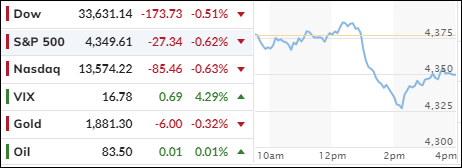
- Moving the markets
U.S. stocks ended lower on Thursday, snapping a four-day winning streak, as investors digested the latest inflation data and a dismal bond auction.
The consumer price index (CPI), a key measure of inflation, rose by 0.4% in September and 3.7% year-over-year, beating the consensus estimates of 0.3% and 3.6%, respectively.
The core CPI, which excludes volatile food and energy prices, matched the expectations of 0.3% monthly and 4.1% annual increases. The inflation data followed a stronger-than-expected producer price index for September, which showed a stronger-than-expected producer price index for September.
The inflation numbers spooked the bond market, sending the yields on the 10-year Treasury note soaring by more than 14 basis points to 4.705%, near its intraday high. The catalyst for the yield spike was a terrible 30-year bond auction, which had the highest yield since 2011.
The bond market rout dragged down the stock market, as higher yields make equities less attractive and raise borrowing costs for companies and consumers.
The sell-off was broad-based, but especially hit the most shorted stocks, which plunged and erased their gains for the year.
Crude oil prices were flat, despite the ongoing conflict between Israel and Hamas, which raised fears of a supply disruption in the Middle East.
The dollar rallied on the back of rising yields, while gold prices gave up their earlier gains. Financial conditions eased, despite the Fed’s recent announcement that it was happy with the market’s tightening response.
Will the Fed change its course if inflation persists, and bond yields continue to surge? How will the stock market react to the Fed’s next move? These are the questions that traders will be asking themselves in the coming days.
2. “Buy” Cycle (12/1/22 to 9/21/2023)
The current Domestic Buy cycle began on December 1, 2022, and concluded on September 21, 2023, at which time we liquidated our holdings in “broadly diversified domestic ETFs and mutual funds”.
Our International TTI has now dipped firmly below its long-term trend line, thereby signaling the end of its current Buy cycle effective 10/3/23.
We have kept some selected sector funds. To make informed investment decisions based on your risk tolerance, you can refer to my Thursday StatSheet and Saturday’s “ETFs on the Cutline” report.
Considering the current turbulent times, it is prudent for conservative investors to remain in money market funds—not bond funds—on the sidelines.
3. Trend Tracking Indexes (TTIs)
The markets started the day with a slight rise, but soon reversed course when the 30-year Treasury bond auction failed to attract enough buyers and turned into the worst one in years.
This pushed bond yields higher and dampened the optimism of investors.
Our Trend Tracking Indexes (TTIs) also declined and moved further below their trend lines, indicating a continued bearish outlook. The International TTI is less negative than the Domestic TTI, as the summary below illustrates.
This is how we closed 10/12/2023:
Domestic TTI: -3.30% below its M/A (prior close –2.08%)—Sell signal effective 9/22/2023.
International TTI: -0.67% below its M/A (prior close -0.09%)—Sell signal effective 10/3/2023.
All linked charts above are courtesy of Bloomberg via ZeroHedge.
Contact Ulli